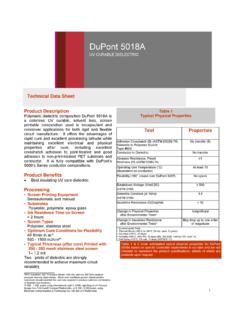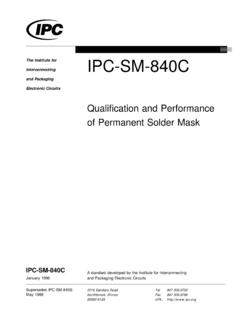Transcription of NEMATEL
1 NEMATEL _____ Polymer Dispersed Liquid Crystals (PDLC) * What is PDLC? Conventional polymer dispersed liquid crystal (PDLC) films consist of a thin (10- 25 m) film of polymer that contains micron-sized droplets of a nematic liquid crystal (Figure 1). In the undriven state the liquid crystal director in the nematic droplets has no preferred orientation with respect to the plane of the film, and a difference between the refractive index of the polymer and the average refractive index of the liquid crystal results in scattering of incident light. For this to occur efficiently the droplet diameter should be of the same order of magnitude as the wavelength of visible light.
2 The film therefore appears opaque. When an electric field is applied to the film, the nematic liquid crystal in the droplets reorients so that the director is parallel to the field, and therefore perpendicular to the plane of the film. If the ordinary refractive index of the liquid crystal (no) is matched to the refractive index of the polymer, then light incident normal to the film does not encounter any variation in refractive index, and passes through the film without being scattered. Such films are therefore opaque in the off state but become clear when a voltage is applied. On removal of the electric field the anchoring forces between the liquid crystal and the polymer droplet walls act to restore the liquid crystal molecules to their original orientation, and the film once again becomes scattering.
3 However, for angles of incidence other than normal, the effective refractive index of the liquid crystal also contains a component of ne, and is not therefore exactly matched to the polymer refractive index. As a result, a small amount of scattering occurs, increasing with angle. These films therefore appear slightly hazy when viewed away from the normal (Figure 2). Uses of PDLC The electrically controlled scattering behaviour enables the PDLC film to act as a light shutter, and as such finds potential use not only as a display technology, but also in other non-display applications.
4 PDLC films, which can be laminated between a variety of transparent, conducting coated substrates ( glass or polyester sheet), have been suggested, demonstrated and commercialised in a variety of novel products. The best known can be classified as vision products, windows and internal partitions, but other applications such as projection screens and lampshades have also been suggested. In some cases dyes have been incorporated and simple reflective displays have been demonstrated. In the future more applications for PDLC may become reality, including the use in complex displays for projection television where silicon active matrix is used as one substrate.
5 *With kind permission of Merck KGaA, Darmstadt a) PDLC film in the off-state, no applied voltage. There is no overall orientation of the liquid crystal molecules within the droplets. Light scattering occurs at the interface between the droplets and the polymer and the polymer matrix due to the refractive index mis-match and the film appears opaque b) PDLC film in the on-state. The liquid crystal molecules within each droplet are aligned with the applied electric field. Normally incident light passes through unaffected and the film appears clear. At wider angles (bottom ray) slight scattering can occur giving rise to off-axis haze Methods of Preparation PDLC films were first demonstrated by Ferguson in 1981, who made the film by emulsifying a polymer, water and a liquid crystal mixture -this method of preparation led to a so-called NCAP (Nematic Curvilinear Aligned Phase) film.
6 Other methods of preparing films having similar electro-optical properties were later described by Doane et al., the most important of these methods being the polymerisation of a homogeneous solution of liquid crystal and pre-polymer. As the resultant polymer forms it causes the liquid crystal to 'phase separate', ideally in the form of discrete droplets. This technique is usually referred to as Polymerisation Induced Phase Separation (PIPS). The polymerisation process may be initiated by heat ( an epoxy resin/curing agent) or by UV light ( an acrylate or thiol-ene system). Other methods of film preparation have also been demonstrated where the phase separation process is controlled by temperature change (TIPS) or solvent evaporation (SIPS).
7 Technical Considerations 1. Off-State Opacity The opacity of a PDLC film is dependent upon: The birefringence of the liquid crystal. A high birefringence increases the difference between the refractive index of the polymer (no) and the average refractive index of the liquid crystal, and therefore leads to more scattering. The use of lower birefringence liquid crystal mixtures leads to a lower opacity. but a wider viewing angle can be reached before the film starts to look hazy. The film thickness Increasing the film thickness increases the amount of scattering The liquid crystal droplet diameter For optimum scattering of white light the droplet diameter should be 1-2 m.
8 At smaller diameters the shorter wavelengths become preferentially scattered and the film takes on a reddish hue. The droplet diameter can be controlled by the rate of phase separation as the film is produced. The proportion of liquid crystal phase separated out of the polymer matrix 2. On-state clarity The clarity of the film in the driven state is optimised by matching the refractive index of the polymer (no) and the ordinary refractive of the liquid crystal (no). In practice, some liquid crystal does not separate, but remains dissolved in the polymer, thus increasing (no). The recommended Merck pre-polymer/liquid crystal combinations have been designed to taking this factor into account.
9 As the viewing angle of a PDLC film increases the clarity tends to drop due to off- axis haze. This results from the incident light encountering a higher effective refractive index in the liquid crystal due to an increasing contribution from the extraordinary refractive index (ne). Off-axis haze can be reduced by using a lower birefringence mixture, but at the expense of the opacity in the off state. 3. Switching voltage The operating voltage is typically in the range 20-80 volts, but very low voltage films for active matrix use are also possible. The voltage required to switch a PDLC film is dependent upon many different factors, including: film thickness dielectric anisotropy of the liquid crystal ( ) resistive and dielectric properties of the film liquid crystal droplet size and shape -smaller droplets require higher voltages for the liquid crystals to be aligned by an electric field configuration of the nematic director within the droplets 4.
10 Response times These are principally governed by droplet size and shape, viscosity, elastic constants, anchoring forces and drive voltage. The total response time (ton + toff) is typically in the range of tens of milliseconds. References Much information is available in the scientific literature on the principles, preparation and uses of PDLC devices. Details of a selective number of these given below: General reviews of PDLC 1. J W Doane, "Polymer Dispersed Liquid Crystal Displays" in IlLiquid Crystals, Applications and Uses", Editor B Bahadur, World Scientific (1991) 2.







